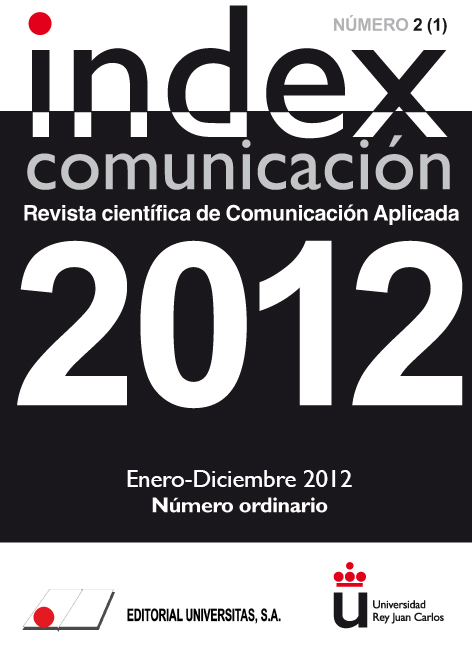Television Coverage of the Cancún Summit: Thematic Agenda, Speeches and Sources in the Spanish News
Keywords:
comunicación, ciencias de la información, medio ambiente, cambio climático, análisis televisivo, media, cumbre del clima, televisiónAbstract
This article wants to show the results on media representation related to the information provided about the Climate Convention in Cancun (Mexico) held between November 29 and December 11, 2010 by the main public and private channels news at Spanish television. A qualitative and quantitative analysis has been performed through 169 news pieces records that represent the projection of the selected news media. Some of the parameters selected for the study are: time occupied by the issue of information, the appearance of their own images or agencies’ images, the presence or absence of the reporter on the part issued, the type of information, the place on the news… These are some of the questions of a protocol that will help to show issues of representation, processing and speech reached at the news covering related to climate change in the media analyzed.Metrics
References
Águila, J.C. “Coverage of Cancun Summit of climate change in Spanish television”. Presented at: Mediating Environmental Change: Exploring the way forward. University of Bournemouth, England, March, 2011.
Arnold Gore, A. “An Inconvenient True” ('Una Verdad Incómoda'). Barcelona, Gedisa, 2007.
Baron, J. “Thinking about global warming”, en Climatic Change, vol. 77, nº 1-2 de 2006. pp. 137–150.
Bjorn, Lomborg. El ecologista escéptico. Madrid, Espasa Calpe, 2003.
Borrat, Héctor. “La información filtrada” , en Annals del periodisme català, nº 14, de 1988, pp. 32 a 38. Barcelona, Col.legi de Periodistes de Catalunya.
Boykoff, Maxwell T. “Media and scientific communication: a case of climate change”, en Geological Society Special Publications, Londres, 2008, v. 305, pp. 11-18.
Boykoff, Maxwell T. “The real swindle”, en Nature Reports Climate Change, vol. 2, marzo 2008, pp. 31-32.
Boykoff, Maxwell T. “Flogging a dead norm. Newspaper coverage of anthropogenic climate change in the United States and United Kingdom from 2003 to 2006, en Area, vol. 39, nº. 2 de 2007.
Boykoff M. y Boykoff, J. “Climate Change and Journalistic Norms: A Case-study of U.S”. Mass-media Coverage. Geoforum, 2007.
Cáceres, Mª.D., Sánchez Calero Mª. L. y Morales Corral, E. “La representación televisiva del cambio climático: las noticias sobre la Cumbre del Clima de Cancún en las cadenas españolas” comunicación presentada en el Congreso de la AI-EC celebrado en Tarragona del 18 al 20 de enero del 2012.
Díaz Nosty, B. “Cambio climático, consenso científico y construcción mediática. Los paradigmas de la comunicación para la sostenibilidad” en Revista Latina de Comunicación Social, 64, de 2009, pp. 99 a 119.
Dilling, L. y Moser, S. “Making climate hot: communicating the urgency and challenge of global climate change”, 2004. Consultado el 27 de marzo de 2012 desde: www.tinyurl.com/yrohxx
Dannoritzer, C. “Comparar, tirar, comprar”. Documental producido por Media 3.14 y Article Z (Francia), en coproducción con Arte France, TVE y Televisió de Catalunya (TV3), 2011.
Fernández Muerza, A., Sanz Alonso, J., Uria Gutiérrez, A., Viota Fernández, N. “Media as partners in education for sustainable development: A Training and Resource Kit”. UNESCO, 2008.
Fontcuberta, M. La noticia. Pistas para percibir el mundo. Barcelona, Paidós, 2003.
Higgins, Paul A. T. “Science in the policy process. Rational Decision-Making or Faustian Bargain”, en BAMS, vol. 89, nº 5, mayo 2008.
Luhmann, N. Sociología del Riesgo [capítulo siete], Universidad de Guadalajara y Universidad Iberoamericana, México, 1992.
Mattelart, A. “Un mundo vigilado”, Barcelona, Paidós, 2008.
Meira Cartea, P. A. y Arto Blanco, M. “Seguridad y Medio Ambiente”, nº 109 (Primer trimestre de 2008); pp. 30-47.
National Geographic Channel y Endesa. (2009): “Cambio climático en España: un desafío para todos”. Documental presentado en el Ministerio de Medio Ambiente y Medio Rural y Marino, el 21 de enero de 2009.
Painter, J. “All doom and gloom”. International TV coverage of the April and May 2007 IPCC reports. (www.tinyurl.com/2qd7ky).
Panos, A. (2006): “Whatever the weather. Media attitudes to reporting climate change”. (www.tinyurl.com/2cp86g).
Pedro, J. “Cambio climático, comunicación y mercado”, en Rebelión, 2007. Consultado el 2 de mayo de 2012 desde: www.rebelion.org/noticia.php?id=55498:pdf
Serrano, P. (2006): “Perlas, patrañas, disparates y trapacerías en los medios de comunicación”. Ediciones de Intervención Cultural. S. L. Editorial El Viejo Topo. Barcelona, 2006.
Sánchez Calero, Mª. L. “La divulgación científica de la meteorología: emisores implicados”, en Revista de la Comunicación Científica Quark. Nº 37-38, Junio de 2006.
Sánchez Calero, Mª. L. y Pardina J. “Internet, el nuevo canal para la información del tiempo” en Estudios sobre el Mensaje Periodístico, vol. Nº 17, de 2011, pp. 615-630.
Stern, N. “El Informe Stern. La verdad del cambio climático”. Barcelona: Paidós, 2007.
Tolan, S. “Coverage of climate change in Chinese media”. PNUD, 2007 (www.tinyurl.com/yscm7v).
UNEP. “El clima en peligro. Una guía fácil del Cuarto Informe del IPCC” de 2009.
Downloads
Published
How to Cite
Issue
Section
License
Authors who submit to this journal agree to the following terms:
Authors retain copyright and ensure the magazine's right to be the first publication of the work as licensed under a Creative Commons Attribution-NoComercial 4.0 International License that allows others to share the work with an acknowledgment of authorship of the work and the initial publication in this magazine, with no commercial purpose.
Authors can establish separate additional agreements for non-exclusive distribution of the version of the work published in the magazine (for example, to an institutional repository or publish it in a book), with an acknowledgment of its initial publication in this journal.
It allows and authors are encouraged to disseminate their work electronically (eg, in institutional repositories or on their own website) prior to and during the submission process, as it can lead to productive exchanges, as well as a citation more early and most of the published work (See The Effect of Open Access).















